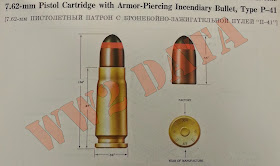Japanese Explosive Ordnance: Army and Navy Ammunition
Today will be the last post about 20mm Army Projectiles. We start to get into post-1940 projectiles which were used in the Ho-5 cannon seen on many late-war Japanese fighters.
20mm High-Explosive Incendiary Tracer Projectile
Overall Length: 19.52cm
Length of projectile: 11.98cm
Length of case: 12.38cm
Filling: Cyclonite, incendiary composition, tracer composition
Fuzing: Type 100 small instantaneous fuze.
Color and Markings: Black body with red band just abaft bourrelet, green and yellow bands before rotating band. Characters (flexible or fixed machine cannon) stenciled on the body.
Used in: Ho-1 (Flexible) and Ho-3 (Fixed) aircraft cannon.
Remarks:
The projectile is made of steel and has two cavities, a main charge cavity and a tracer cavity, separated by a septum. The main charge cavity contains two pellets, the forward one, fitting around the fuze gaine, is cyclonite while the after one is an incendiary mixture.
Type 100 Mod 2 20mm I.T. (Self-Destroying) Projectile
Overall Length: 20.93cm
Length of projectile: 8.32cm
Filling: Incendiary composition, tracer composition
Fuzing: Type 100 small instantaneous fuze
Color and Markings: Black body with red band just abaft bourrelet, green and yellow bands before rotating band. Characters (Type 100 Mod 2) are stenciled on the body.
Used in: Type 98 anti-aircraft / anti-tank gun
Remarks:
This is the same projectile as the type 100 and type 100 Mod 1 H.E.T. but there is no high explosive other than that used in the gaine.
20mm Armor-Piercing Tracer Projectile
This projectile came in 3 variations: Type 97 anti-tank gun, Ho-1 and Ho-3 aircraft cannons, and Type 98 anti-aircraft and anti-tank gun.
Overall Length: (97) 19.36cm (Ho-) 19.36cm (98) 20.95cm
Length of projectile: (97) 8.01cm (Ho-) 8.09cm (98) 8.01cm
Weight of projectile: (All) 156g
Length of case: (97) 12.38cm (Ho-) 12.38cm (98) 13.97cm
Filling: Tracer composition
Color and Markings:
Hard round (type 100): black body, green and white bands before rotating band.
Medium Round (Type 97) has (type 100) stenciled on the body, black body, green band before rotating band.
Soft round (Type 97 substitute) black overall.
Medium Round Stencil
Remarks:
This projectile is a solid steel shot with a tracer cavity drilled into the base. This projectile, with different colored tracers and markings is used in three guns. There are three types of rounds differing in grades of hardness of steel.
Ho-5 20mm Ammunition
Excerpt from the Manual: The latest Army 20mm gun developed is the Ho-5 aircraft gun which is of excellent design and represents a considerable improvement over previous Army 20mm aircraft machine guns.
Case properties
Length: 9.48cm
Diameter of base: 2.46cm
Material: Brass
Weight (Empty): 113.5g
Remarks:
The case is of the rimless type and has a slight taper toward the neck.
Propellant: The propellant is 21.4g of graphited smokeless powder in fine cylindrical grains.
Type 2 and Type 2 Modified 20mm H.E.I. Projectile
Overall Length: 14.6cm
Length of projectile: 6.5cm (Fuzed)
Weight of projectile: 77.4g (Fuzed)
Weight of filling:
-Cyclonite (Type 2 Modified): 3.4g
-Cyclonite (Type 2): 0.4g
-Incendiary composition: 3.7g
Filling: Cyclonite and incendiary composition
Fuzing:
-Type 2: Type 2 small instantaneous or Type 2 small instantaneous modified type.
-Type 2 Modified: Type 4 super-detonating fuze.
Color and Markings:
-Type 2: Black overall and, sometimes, yellow band around body.
-Type 2 Modified: projectile is painted silver-gray overall
Remarks:
The difference between the Type 2 and the Type 2 modified is the fuze. The Type 2 projectiles uses a fuze that has an external gaine and thus has less explosive filling than the Type 2 Modified projectile which uses a fuze with the gain built into the fuze body.
Type 4 20mm H.E.I. (Ma 202) Projectile
Overall length: 14.6cm
Length of projectile: 6.6cm
Weight of projectile: 78.2g (fuzed)
Weight of filling:
-P.E.T.N.: 3.2g
-Incendiary composition: 8.7g
Filling: P.E.T.N., and incendiary composition (barium nitrate, aluminium powder, magnesium powder, and wax)
Fuzing: Fuzeless
Color and Markings: Black overall with characters (202)
Remarks:
The projectile is made of steel with a brass nose piece threaded to it. The nose piece is filled with P.E.T.N. and is designed to explode by the crushing action of impact. An incendiary mixture contained in the steel body is separated from the high explosive by a felt pad and a threaded brass disc. This disc has two lead-in holes.
Type 2 20mm Armor-Piercing Tracer Projectile
Overall length: 14.6cm
Length of projectile: 6.35cm
Weight of projectile:
-Soft Round: 112.7g
-Medium Round: 116.7g
-Hard Round: 119.5g
Weight of filling: 7g
Filling: Tracer composition
Color and Markings:
-Soft Round: Black overall
-Medium Round: Black with green band around body.
-Hard Round: Black with a green and a white band around body.
Characters (Type 2) are stenciled on the body
Remarks:
There are three different models of this projectile differing in the grades of hardness of the steel. This difference is indicated by the color markings.
20mm Practice Projectile
Overall length: 14.6cm
Length of projectile: 6.5cm
Weight of projectile: 81g
Filling: None
Color and Markings: Black overall
Remarks:
The projectile approximates the shape of the Type 2 H.E.I. projectile. It is unfilled and closed at the base by a threaded plug.
Next time: 37mm Cannon Projectiles and more!














































